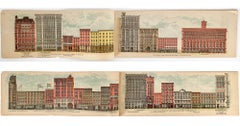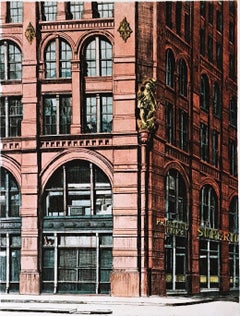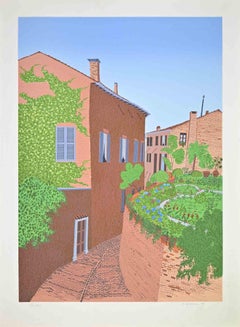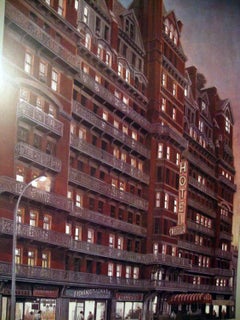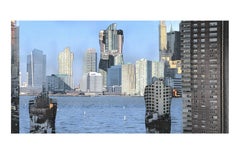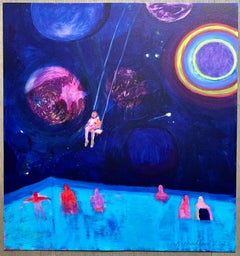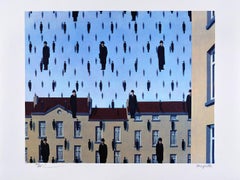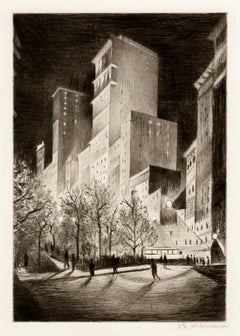Apartment Building Figurative Prints
to
3
2
4
5
3
Overall Width
to
Overall Height
to
4
2
1
3
1
1
1
1
2
7
5
3
2
1
8
6
569
26,730
14,636
10,486
8,987
7,664
6,976
4,518
4,100
2,369
2,031
1,921
1,865
1,702
1,466
1,463
1,462
1,457
1,282
1,220
4
4
3
2
2
1
6
9
5
Art Subject: Apartment Building
A Pictorial View of Broadway, 1899 - 74 Chromolithograph plates
Located in Middletown, NY
What did Broadway look like at the turn of the 20th Century? Here is a scarce and important block-by-block view published in 1899 by The Mail and Express
New York: The Mail and Expr...
Category
Late 19th Century American Realist Figurative Prints
Materials
Lithograph
Puck Corner, SOHO, New York signed, numbered by top architectural artist, Framed
By Richard Haas
Located in New York, NY
Richard Haas
Puck Corner, SOHO, New York, 1971
Etching and Aquatint (affixed to white matting)
Hand signed and numbered 10/100 by the artist on the lower front
Elegantly matted and f...
Category
1970s Realist Figurative Prints
Materials
Pencil, Etching, Aquatint
Gran vía
Located in BARCELONA, ES
Antonio López
Engraving
Gran Vía
2024
Signed and numbered (32/100)
From the publisher Talleres del Prado
Certificate of authenticity issued by Talleres el Prado
68x70cm
Category
2010s Realist Figurative Prints
Materials
Etching
$10,780
Urban Landscape - Lithograph by Paola Perusco - 1980s
Located in Roma, IT
Lithograph realized in 1980s.
Hand signed and numbered.
Edition of 100.
Excellent condition.
Category
1980s Contemporary Figurative Prints
Materials
Lithograph
Chelsea Hotel, Sunset
By Richard Haas
Located in New York, NY
Richard Haas
Chelsea Hotel, Sunset, 1980
Offset Lithograph poster on paper
Pencil signed on the front
23 1/4 × 21 1/2 inches
Unframed
This striking offset lithograph poster by the world's top architectural muralist Richard Haas presents a detailed portrait of the historic New York City landmark - the legendary Chelsea Hotel. Many famous people stayed at this storied hotel. Nancy Spungen...
Category
1980s Realist Landscape Prints
Materials
Offset
Memory 9/11 1099 - Signed, Limited Edition Contemporary Fine Art Print
Located in New York, NY
This print from Linda Stein's Covid Story series was developed while she sheltered in place on the 31st floor of her New York City apartment building. The imagery draws from recurrin...
Category
2010s Contemporary Figurative Prints
Materials
Archival Pigment
$880 Sale Price
20% Off
The Defenders I Want To Be 1086 - Signed, Limited Edition Contemporary Print
Located in New York, NY
This print from Linda Stein's Covid Story series was developed while she sheltered in place on the 31st floor of her New York City apartment building. The imagery draws from recurrin...
Category
2010s Contemporary Figurative Prints
Materials
Archival Pigment
Central Synagogue Lexington Avenue Looking North Etching and aquatint S/N Framed
By Richard Haas
Located in New York, NY
Richard Haas
Central Synagogue - Lexington Avenue Looking North, 1991
Etching and aquatint on wove paper
Signed, dated and numbered 8/35 in graphite pencil on the front; bears the or...
Category
1990s Realist Landscape Prints
Materials
Etching, Aquatint
23 Flats by Barry Cawston 90x82.5 C-type Photographic Print Only
Located in Coltishall, GB
Communal living in Rio de Janeiro
–
High-rise communal living was once seen as a great step forward for mankind. Cawston’s Tenement series captures the individual within the collect...
Category
21st Century and Contemporary Other Art Style Color Photography
Materials
C Print
Building
By Heinz Wehlisch
Located in Kansas City, MO
Heinz Wehlisch
Building
Color etching
Signed by hand
Size: 15.2 × 22.4 on 20.1 × 26.9 inches
COA provided
Heinz Wehlisch was a modern artist of the late 20th century and worked in Berlin. He was a member of the professional association of visual artists in Berlin from 1946-1980; his specialty were etchings but also watercolors based on old postcard...
Category
1970s Modern Prints and Multiples
Materials
Etching
$99 Sale Price
77% Off
La Fete a Honfleur
Located in San Francisco, CA
This artwork, "La Fete a Honfleur" c.1980 is a original colors serigraph on Wove paper by French artist (Fanch) Francois Ledan, born 1949. it is hand signed an...
Category
Late 20th Century Modern Landscape Prints
Materials
Screen
Il Rimore dei Pattini a Rotelle - Offset by Giuseppe Chiari - 1974
Located in Roma, IT
Offset print.
Hand signed
Edition of 100.
Category
1970s Contemporary Figurative Prints
Materials
Offset
L'Hopital - Lithograph by Antonio Fontanesi - 1854
Located in Roma, IT
This splendid lithograph L'hopital is part of the series of 20 prints dedicated to views of the city of Geneva, engraved by the Italian artist Antonio Fontanesi in 1854. The lithogra...
Category
1850s Figurative Prints
Materials
Lithograph
Paradox x CPT.OLF 16-19 (II)- The Exhibition (Urban Art, Snapshot, Exploration)
Located in Kansas City, MO
CPT.OLF
Paradox x CPT.OLF 16-19 (II)- The Exhibition (Urban Art, Snapshot, Exploration)
Exhibition Poster for "URBAN SPREE Galerie, Berlin"
Year: 2019
Size: 33.07 x 23.62 inches (84...
Category
2010s Street Art Landscape Prints
Materials
Lithograph, Offset
Related Items
La Vilaine, France
Located in San Francisco, CA
Artist: Roger Hebbelinck (Belgian, born 1912)
Title: La Vilaine
Year: Circa 1965
Medium: Color etching with aquatint
Edition: Numbered 30/350 in p...
Category
Mid-20th Century Realist Landscape Prints
Materials
Aquatint
Swing Over Pool
Located in London, GB
Artist: Katherine Bradford
Title: Swing Over Pool
Medium: Archival pigment print with silkscreen shimmer varnish and matte seal on Somerset Tub Sized Radiant White 410gsm paper.
han...
Category
2010s Contemporary Landscape Prints
Materials
Archival Pigment
Put Fighting Blood in Your Business
Located in Spokane, WA
Original WW1 poster. Put Fighting Blood in Your Business. Here’s his record! Does he get a Job? Arthur Woods, Assistant to the Secretary of...
Category
1910s American Realist Landscape Prints
Materials
Lithograph
"The Slope Near the Bridge" Paul Sample, Mid-Century, American Snowy Landscape
By Paul Sample
Located in New York, NY
Paul Sample
The Slope Near the Bridge, 1950
Signed in pencil lower left
Lithograph on wove paper
Image 8 15/16 x 12 15/16 inches
Sheet 11 5/16 x 15 1/16 inches
From the edition of 25...
Category
1950s American Realist Figurative Prints
Materials
Paper, Lithograph
$900
H 16.25 in W 20.25 in
Billy Childish - Moose
Located in London, GB
Moose, 2020
Archival print on heavy matt stock
30.5 x 38 cm
Edition of 200
signed and numbered by the artist
Billy Childish is a prolific British artist, musician, and writer known...
Category
2010s Contemporary Figurative Prints
Materials
Archival Pigment
The Creation
Located in London, GB
The Creation, 2024
Archival print on heavy matt stock paper
38.1 x 30.5 cm
Edition of 200 signed and numbered by the artist
Billy Childish is a prolific British artist, musician, an...
Category
2010s Contemporary Landscape Prints
Materials
Archival Pigment
'Plowing It Under' — WPA Era American Regionalism
Located in Myrtle Beach, SC
Thomas Hart Benton, 'Goin' Home', lithograph, 1937, edition 250, Fath 14. Signed in pencil. Signed in the stone, lower right. A fine, richly-inked impression, on off-white, wove pape...
Category
1930s American Realist Figurative Prints
Materials
Lithograph
Yelding the Right of Way
Located in San Francisco, CA
This artwork titled "Yelding the Right of Way" c.1975 is a color offset lithograph by renown western artist Arnold Friberg, 1913-2010. It is hand signed...
Category
Late 20th Century American Realist Figurative Prints
Materials
Lithograph
Tigre couché à l'entrée de son antre (Tiger Lying at the Entrance to its Lair)
Located in Middletown, NY
Etching, drypoint, and roulette on watermarked Hallines cream laid paper, 3 3/4 x 5 7/8 inches (95 x 148 mm), full margins. A very good impression of this charming image, with all of...
Category
Early 19th Century Realist Animal Prints
Materials
Laid Paper, Drypoint, Etching
The Ayase River and Kanegafuchi, Summer, One Hundred Famous Views of Edo
Located in Soquel, CA
The Ayase River and Kanegafuchi, Summer, One Hundred Famous Views of Edo
Summer on the Ayase River by Hiroshige (Ando) Utagawa (Japan, 1797 - 1858 ). Woodcut circa 1856.
Ima...
Category
1850s Realist Figurative Prints
Materials
Ink, Woodcut
$1,080 Sale Price
20% Off
H 19.5 in W 14.13 in D 0.38 in
NOTRE QUARTIER Signed Lithograph, Nostalgic French Street Market Scene
By Ari Gradus
Located in Union City, NJ
NOTRE QUARTIER is a hand drawn original lithograph by the artist Ari Gradus printed in 13 colors using traditional hand printmaking techniques on archival Arches paper 100% acid free...
Category
1970s Contemporary Landscape Prints
Materials
Lithograph
$399
H 21.5 in W 29.5 in
The Windmill
Located in San Francisco, CA
This artwork titled "The Windmill" 1641 is an etching on paper After Rembrandt Van Rijn, 1606-1669, plate engraved By French renown engraver Charles Armand Durand, 1831-1905. Signatu...
Category
17th Century Realist Figurative Prints
Materials
Etching
Previously Available Items
RENÉ MAGRITTE - GOLCONDE, 1953 Limited edition Lithograph - Surrealism
Located in Madrid, Madrid
GOLCONDE, 1953
Date of creation: 2010
Medium: Lithograph on BFK Rives Paper
Edition: 275
Size: 60 x 45 cm
Observations: Lithograph on BFK Rives paper plate signed and numbered of a l...
Category
Mid-20th Century Surrealist Figurative Prints
Materials
Lithograph
H 23.63 in W 17.72 in D 0.08 in
'Three AM: A Corner by Madison Square at Night' — 1920s Modernism
Located in Myrtle Beach, SC
Christopher R. W. Nevinson, 'Three AM: A Corner by Madison Square at Night', drypoint, 1920, edition 75, Black 72. Signed in pencil. A superb, richly-inked impression in dark brown i...
Category
1920s Modern Figurative Prints
Materials
Drypoint
Mychael Barratt, Wes Anderson’s Dog – Page Street, Contemporary Art
Located in Deddington, GB
Mychael Barratt
Wes Anderson’s Dog – Page Street
Limited Edition Print
Screen Print on Paper
Edition of 50
Image Size: H 50cm x W 50cm
Paper Size: H 68...
Category
21st Century and Contemporary Contemporary Landscape Prints
Materials
Paper, Screen
Whimsical Naive Paris Park Scene Folk Art Fanch Lithograph
Located in Surfside, FL
Born in 1949 in the region of Brittany in France, Francois “Fanch” Ledan is the youngest child of a doctor and a dentist. In his youth, he was educated locally but it was not long before he decided to study in Paris. It was here that he earned three bachelor’s degrees in mathematics, science, and philosophy by the age of nineteen. In addition, this city, with its charm and passionate life, drew Fanch into its famed art scene.
While he continued along a professional path, he explored his artistic interests and traveled extensively. A combination of these aspects of his life led him to enroll in an MBA program at Sacramento State University in 1972 while pursuing a career in art in San Francisco. The following year was an auspicious one for Fanch - he earned his MBA and was offered his first exhibition after showing some of his paintings to a San Francisco gallery director. He began to realize he could make a living by chasing his passion, and spent the next decade and a half living in California and traveling to France and other European countries for artistic inspiration. Fanch’s popularity and fame grew as he exhibited his art all around the world, including locations as diverse as London, New York, Los Angeles, and Tel Aviv.
Fanch’s inspiration expresses itself in his signature style. His work is often a study in contrasts, presenting a careful balance of the real and the possible in his interior and exterior landscapes. The exuberance evident in the color and bustle of the images he paints are balanced by his worldly knowledge and an unidentifiable underlying tension. Using high vantage points and deep, distant views, Fanch has the talent of drawing viewers into his work while keeping them removed. His skills intrigue and fascinate collectors around the world, making Fanch one of the most respected and noted artists of today.The art crafted by Fanch Ledan, known today primarily by his Breton nickname “Fanch,” is inextricably tied to the events of his life. While a student in Paris at the Ecole Superieure des Sciences Commerciales in 1968, Fanch’s artwork was accepted by several galleries and major European exhibitions. He soon abandoned commercial design in favor of full-time studies in painting and fine art. In 1972 he entered the MBA program at Sacramento State University and started to display his original acrylic paintings in galleries in California and New York.
In 1975, after he learned the difficult technique of lithography, his first edition of lithography was published by Tallandier in Paris. He is noted for delightful scenes of his native Brittany and locales from around the world, executed in a colorful “primitive” or “naïve” style. Similar in feel and style to Michel Delacroix, Jan Balet, James Rizzi and Charles Fazzino. Fanch creates imaginary scenes that run the gamut from worldly and exotic destinations to intimate interiors. Both his landscapes and interiorscapes have a romantic mood and beckon the viewer to enter them. He tries to express both a sense of whimsy and technical detail in each scene. Fanch will often create combinations of locations that cannot exist in reality, like a view of the Taj Mahal or the Pyramids of Egypt...
Category
20th Century Folk Art Landscape Prints
Materials
Lithograph
Still Thinking About These?
All Recently ViewedMore Ways To Browse
England Church Oil Painting
English Deer Painting
English Fox Hunt Painting
English Toy Terrier
Enrique Martinez Celaya
Eric Aho
Eritrea Art
Ernest Chateignon
Erotic Art Animal
Eugene Chigot
Eugene Devaud De Madelin
Eugene Jardin
Faith Sheppard
Fearless Girl
Felix Armand
Florida Everglades Painting
Ford Gran Torino
Frances Baker
